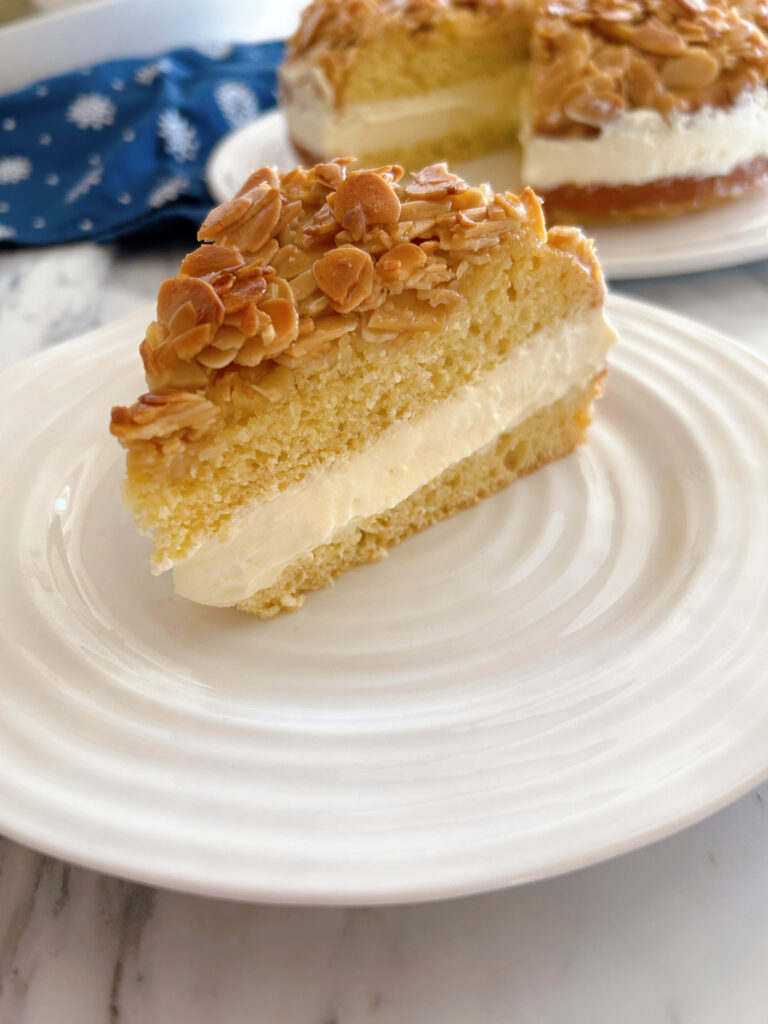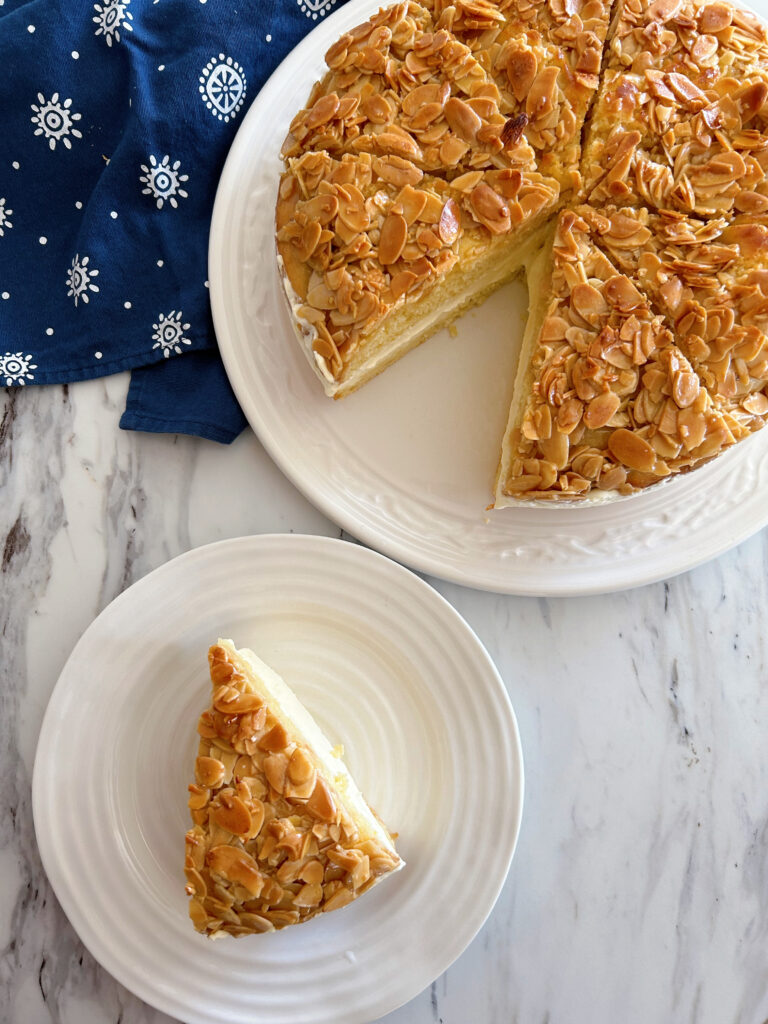This blog post feels like a strange one to share. Not because it isn’t delicious (it is!), but because the memory that will always be tied to my experience of this german bee sting cake is on the sombre side. You see, my Oma has been in and out of hospital (mostly in) for the better part of six months. On one of my many, many visits to see her we ended up on the topic of cakes and other goodies. She has never made a bee sting cake before, but as she recalled and shared her memory of particular friends who would always make one when they visited her eyes sparkled and she licked her lips as if able to taste it right then. At that moment I knew exactly what I would be making to celebrate her 93rd birthday!
At first I dug into her very old cookbook written entirely in German and used my limited knowledge and google translate to decipher the bee sting cake instructions, but I had to find more details. I knew from past failures (like my first attempt at this german buttercream cake) that these old books seriously lacked the details I needed to make sure the recipe would be a success. Attempt #1 was a combination of the recipe from my Oma’s old cookbook and step by step instructions from a similar recipe online. The filling was to.die.for but the cake was dry and just didn’t quite do it for me. Back to the drawing board.
After scouring further recipes I stumbled upon this one by Smitten Kitchen, however, I felt deflated after reading the comments with all the disasters that other people had run into. So I sat down, pulled out my notebook and combined my Oma’s old recipe, the instructions from the first online recipe, the Smitten Kitchen recipe AND the edits to that recipe that other bakers had made. Phew. I have a little of my Oma’s determination I think. 😉
The second attempt at bee sting cake is the one you see above and below. The cake dough is soft and moist while still being a yeast dough and the topping is toasted, caramelized, crunchy almonds. Yum. BUT the pièce de résistance is the filling. Essentially homemade vanilla pudding lightened with whipped cream, I would forego everything else about this cake just for the filling if I had to choose between them.
I practically skipped into Oma’s hospital room on her birthday to present her with a birthday cake I could not be more proud of. We all enjoyed a slice to celebrate her and she declared it a real bee sting cake (meaning that if I left a slice outside a bee would certainly be attracted to it and come “sting” the cake).
Happy baking!
Sophie

If you liked this recipe you are going to love these ones!
German Apple Custard Cake with Spelt Shortcrust
German Buttercream Torte
Authentic Black Forest Cake (Schwarzwälder Kirschtorte)

German Bee Sting Cake (Bienenstich)
Ingredients
Vanilla Cream Filling
- 2 tbsp corn starch
- 4 tbsp granulated sugar
- 1/8 tsp sea salt
- 2 large egg yolks
- 250 ml homogenized milk
- 1 tsp vanilla extract
- 250 ml whipping cream
Cake
- 2 1/4 tsp instant yeast
- 50 g granulated sugar
- 270 g organic, all purpose wheat flour
- 3/4 tsp sea salt
- 3/4 cup homogenized milk at room temperature
- 2 large eggs at room temperature
- 56 g unsalted butter melted and cooled
- 1 tsp lemon zest
Honey Almond Topping
- 84 g unsalted butter at room temperature
- 67 g granulated sugar
- 60 g honey
- 2 tbsp whipping cream
- 2 pinches of sea salt slightly less than 1/8 tsp
- 150 g sliced almonds
Instructions
Make the Pastry Cream
-
In a medium sized bowl, whisk together the sugar, cornstarch, and salt. Add the egg yolks and whisk together until the mixture is pale and smooth, about 1 minute. At first the mixture will seem too dry but keep whisking and it will loosen and then become smooth. Whisk in the milk, a splash at a time for the first 1/2 cup, until all of the milk has been fully incorporated.
-
Pour the mixture into a small saucepan and cook over medium-low heat while whisking constantly. Once it begins to gently boil, continue to cook for an additional 1 minute to cook out the starch. Remove from the heat and whisk in the vanilla extract.
-
Push the pastry cream through a fine-mesh strainer into a clean bowl using a spatula. Cover with plastic wrap and place it directly on the surface of the pastry cream. Chill in the fridge while preparing the cake.
Prepare the Almonds
-
Preheat your oven to 350F and spread the almonds on a large baking sheet. Toast for 10 minutes or until lightly toasted. Set aside to cool.
Make the Cake
-
In the bowl of a stand mixer or a large bowl add the instant yeast, sugar, flour and salt. Whisk together to combine. Whisk together the melted and cooled butter, milk, eggs and lemon zest in the saucepan that the butter was melted in. Pour the wet ingredients on top of the dry ingredients and fit the stand mixer with a paddle attachment or use a hand mixer.
-
Mix on low-medium speed for 2 to 3 minutes until completely incorporated. Scrape down the sides of the bowl, cover tightly and allow to rise for 60 minutes. Note that the mixture will not double, however, it will puff up and look bubbly.
-
Butter a 9" springform pan then line the bottom with a round of parchment paper. Cut a second round of parchment paper for the topping and set aside. Butter the parchment paper as well. Once the batter has finished its first rise, stir it with a spatula to deflate it, then empty it into the prepared springform pan and gently spread evenly so it fills the bottom of the pan. Cover tightly again and allow to rise for 30 minutes. Note that is will not double at this point either, but will puff up slightly again and look bubbly.
Make the Topping
-
While the cake is rising for the second time, make the topping. In a medium saucepan, combine and heat the butter, sugar, honey, whipping cream and salt over medium heat. Bring to a simmer and allow the mixture to boil for 3-5 minutes while stirring frequently. The mixture will turn a shade darker. If you have a candy thermometer, the mixture is done when it reaches 240F. Stir in the lightly toasted almonds, then empty the mixture out onto the second circle of parchment paper. Use a spatula to spread the mixture evenly, leaving a 1/2 inch gap around the edge of the parchment circle. Set aside to cool.
Bake the Cake
-
Preheat your oven to 350F. Bake the cake on the center rack for 12 minutes then remove from the oven, peel the topping off the parchment circle and gently place the topping onto the cake. Bake for another 15-17 minutes or until a toothpick inserted into the center comes out clean. Move the cake to the top rack and broil on high for 1-2 minutes to darken the almond topping (optional). Remove and place the cake and springform pan on a wire rack to cool for 30 minutes.
-
After 30 minutes, run a sharp knife around the outside of the cake and remove the springform pan sides. Allow the cake to cool completely.
Finish Preparing the Filling
-
In the bowl of a stand mixer with the whisk attachment or in a large bowl with a hand beater, beat the whipping cream until stiff peaks form.
-
Remove the pastry cream from the fridge and use a whisk to stir it up until it is smooth and creamy again. Add half of the whipped cream and gently combine with a spatula then fold in the rest of the whipped cream.
Assemble the Cake
-
Place the cake on a cutting board and cut it into two layers using a long serrated knife or bread knife. Move the top layer to another cutting board or onto a wire cooling rack. Place the bottom layer onto a cake plate or serving platter. Place the outer ring of the spring form pan around the bottom layer, then spread the filling evenly over the bottom layer of the cake, right to the edges of the spring form pan.
-
Move the top layer to a cutting board if it was on a cooling rack and use a long serrated knife or bread knife to cut the top layer into 8 or 12 slices. Place each slice inside the spring form pan ring on top of the filling. Gently press down on each piece to adhere it to the filling below.
-
Cover and chill the entire cake as is for a few hours in the fridge. This helps set the filling and makes the cake easier to slice. When ready to serve, run a sharp knife around the inside edge of the spring form pan, then remove it from the cake. Cut into slices all the way through the filling and the bottom layer and serve.


